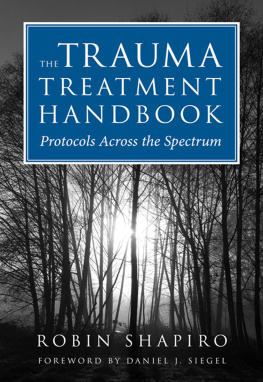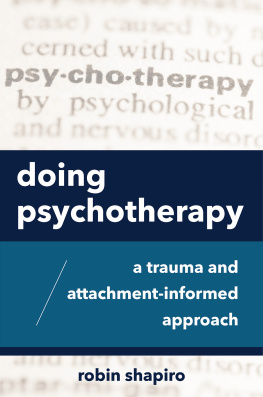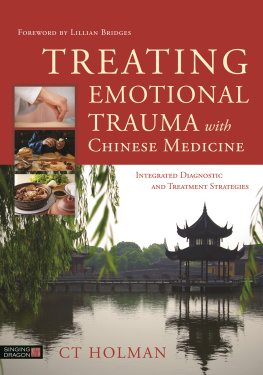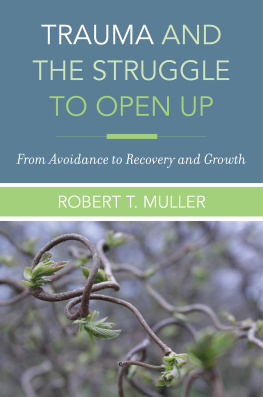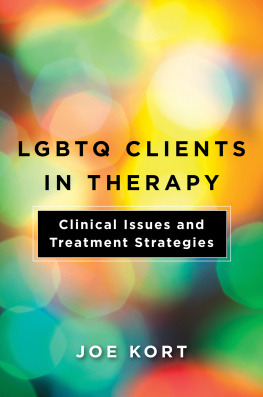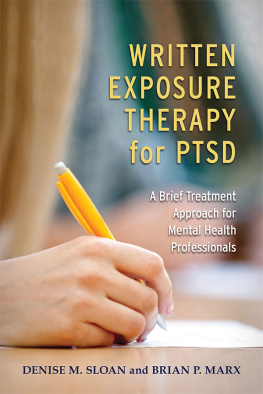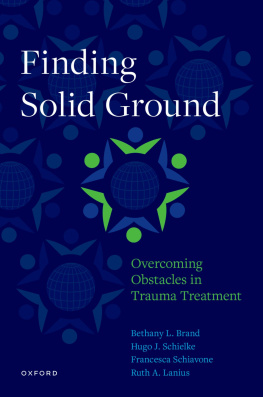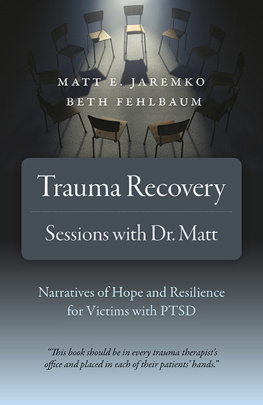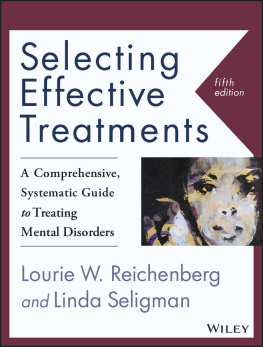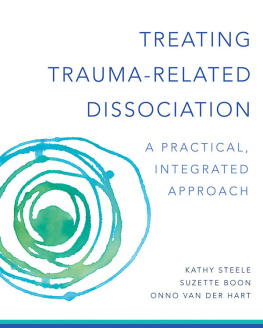The TRAUMA TREATMENT HANDBOOK
Protocols Across the Spectrum
ROBIN SHAPIRO
Foreword by Daniel J. Siegel

A N ORTON P ROFESSIONAL B OOK
W. W. Norton & Company
New York London
Copyright 2010 by Robin Shapiro
Foreword copyright 2010 by W. W. Norton & Company, Inc.
All rights reserved
For information about permission to reproduce selections from this book, write to Permissions, W. W. Norton & Company, Inc., 500 Fifth Avenue, New York, NY 10110
Library of Congress Cataloging-in-Publication Data
Shapiro, Robin.
The trauma treatment handbook: protocols across the spectrum / Robin Shapiro; foreword by Daniel J. Siegel.1st ed.
p.; cm.
A Norton professional book.
Includes bibliographical references.
ISBN: 978-0-393-70674-1
1. Post-traumatic stress disorderTreatment. 2. Psychic trauma. I. Title. [DNLM: 1. Stress Disorders, Post-Traumatictherapy. 2. Psychotherapymethods. 3. Stress Disorders, Post-Traumaticpsychology. WM 172 S525t 2010]
RC552.P67S45 2010
616.85'21dc22 2010013117
W. W. Norton & Company, Inc., 500 Fifth Avenue, New York, N.Y. 10110
www.wwnorton.com
W. W. Norton & Company Ltd., Castle House, 75/76 Wells Street,
London W1T 3QT
Dedicated to the memory of my mentor, Thom Negri, and to all the past and present clinicians, innovators, teachers, and clients who have taught me to heal trauma.
CONTENTS
ACKNOWLEDGMENTS
I didnt write this book alone. Thank you to all the people who helped me directly. The obvious ones are:
Kathy Steele, who, seemingly patiently, set me straight about many aspects of structural dissociation. For anything that is correct about SD, I give her credit. For anything that isnt, please blame me.
David Calof, my long-time consultant, who provided much of the structure and information for the clinical hypnosis chapter.
David Kearney, a physician who told me about his yoga and mindfulness training program at the Seattle VA.
Martha Jacobi, who let me crib from her prepublished descriptions of two kinds of somatic therapies.
Diana Fosha, who allowed me to steal liberally from a section of her book about psychodynamic therapies.
Sharon Stanley, who explained somatic transformation to me.
Marcia Herival, who vetted the exposure and CBT chapters and gave me more modalities to research.
Wayne McClesky, who reviewed the energy psychology chapter (years after teaching me most of what I know about it).
Jim Cole, who did the same for the reenactment protocol, the only intervention I know that ends with a giggle.
Trisha Pearce, who filled me in about working with military and veterans during a 40-minute phone call and had already trained me through her wonderful volunteer Soldiers Project NW.
Thank you to all the other teachers, trainers, authors, and consultants who taught me so much about trauma and its treatments. I hope I did you justice and that I got the references right.
Thank you, in advance, to each of you who are choosing to heal trauma as your lifes work.
Thanks to the people at Norton Professional Books who suggested I write this book and urged me to keep it user-friendly. Thank you to Andrea Costella, Kristen Holt-Browning, and Vani Kannan for guiding me, once again, through the publishing process. I tried to get it write, I mean, right, the first time.
Thank you, one more time, to my first reader and first editor, my mother, writer Elly Welt. I continue to improve my writing under your tutelage. Yes, I got the message about italics and quotation marks.
And to my long-suffering husband, Doug Plummer, who supported me in all ways through yet another book, including providing two more wonderful photos: I adore you.
ACRONYMS
AB/ISTDP: attachment-based intensive short-term dynamic psychotherapy
ACT: acceptance and commitment therapy; accept, choose, take action
AEDP: accelerated experiential-dynamic psychotherapy
AET: accelerated empathetic therapy
ANP: apparently normal part (in structural dissociation)
APA: American Psychological Association
ASD: acute stress disorder
BLS: bilateral stimulation (in EMDR)
BPD: borderline personality disorder
BSP: Brainspotting
CBT: cognitive behavior therapy
COS: combat operational stress
CPT: cognitive processing therapy
CT: cognitive therapy
CTSD: complex traumatic stress disorders
DBT: dialectical behavior therapy
DDIS: Dissociative Disorders Interview Scale
DDNOS: dissociative disorder not otherwise specified
DDP: dyadic developmental psychotherapy
DES: Dissociative Experiences Scale
DESNOS: disorders of extreme stress, not otherwise specified
DID: dissociative identity disorder (formerly multiple personality disorder, MPD)
DNMS: developmental needs-meeting strategy
DSM-IV: Diagnostic and Statistical Manual of Mental Disorders
DTD: developmental trauma disorder
EFT: emotional freedom technique
EMDR: eye movement desensitization and reprocessing
EP: emotional part (in structural dissociation)
EX: exposure therapy
HSP: highly sensitive person
IFS: internal family systems
ISSTD: International Society for the Study of Trauma and Dissociation
ISTDP: intensive short-term dynamic psychotherapy
LENS: low-energy neurofeedback system
MBSR: mindfulness-based stress reduction
NAS: nurturing adult self (in DNMS)
PAS: protective adult self (in DNMS)
PE: prolonged exposure
PTP: pretraumatized person (in the structural dissociation model)
PTSD: posttraumatic stress disorder
REBT: rational emotive behavior therapy
RP: reenactment protocol
SCS: Spiritual Core Self (in DNMS)
SD: structural dissociation
SDM: strategic developmental model
SDQ: Somatoform Disorder Questionnaire
SE: somatic experiencing
SIDS: sudden infant death syndrome
SIT: stress inoculation therapy
SP: sensorimotor psychotherapy
SSRI: selective serotonin reuptake inhibitor
STDP: short-term dynamic psychotherapy
TBI: traumatic brain injury
TFT: thought field therapy
WTF?: response to so many acronyms!
FOREWORD
Trauma is an experience that overwhelms our ability to cope and leaves our relationships and our brains with the challenge of finding a way to remain integrated and functioning well. In many ways, a psychotherapist working with individuals who have been traumatized needs to use the trusting therapeutic relationship to cultivate healing by attuning to the internal world of the client and resonating with that experience. Robin Shapiro has written a practical guide to a wide range of treatment strategies for trauma that offer useful approaches to tracking and transforming traumatic symptoms and guiding the individual toward healing.
Healingbecoming wholecan be seen as a process of integration, linking the internal neural circuits that have become disconnected during the overwhelming events in a persons life. For therapists, staying present with trauma is not easy, and having a wide range of creative steps easily accessible in the clinicians tool kit makes the process more likely to be effective. The journey to learn a broad range of treatment approaches included in this book has enabled Shapiro to offer her clinical wisdom; she demonstrates in clear summaries and helpful clinical vignettes how to apply these specific techniques in particular clinical situations.
All psychotherapy needs to be individually tailored to the person presenting for treatment. In this way, we as therapists need to have a spectrum of interventions at our disposal in order to create the most effective and individually sculpted therapeutic experiences. When I first skimmed over this handbook, I thought that the lack of scientific studies supporting many of the various individual approaches would lead me to call the author and say that I could not write this foreword. But as I read each chapter and reflected on my own development as a therapist, I realized that this compilation was indeed a very helpful compendium of usefuleven if mostly not scientifically provenapproaches that would help any clinician working with traumatized individuals. These are the tools of the art of psychotherapy. So I read on and found myself soaking in the authors sensitivity, her directness, her compassionate reflections on the therapeutic process, and her skill at extracting the best from a range of clinical strategies to help the healing process evolve and be more likely to find a window of opportunity to make lasting change possible.

